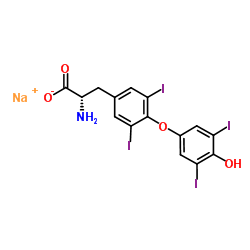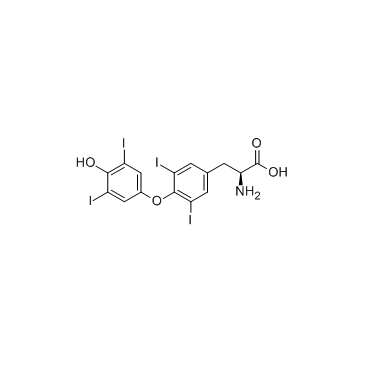55-03-8
| Name | levothyroxine sodium anhydrous |
|---|---|
| Synonyms |
Sodium l-thyroxin
L-3,3',5,5'-Tetraiodothyronine Sodium Salt L-Thyroxine monosodium salt Levaxin Euthyrox L-Tyrosine, O- (4-hydroxy-3,5-diiodophenyl)-3,5-diiodo-, monosodium salt Sodium Levothyroxine Eltroxin Thyro-Tabs O-(4-Hydroxy-3,5-diiodophenyl)-3,5-diiodo-L-tyrosine Monosodium Salt Levothroid L-Tyrosine, O-(4-hydroxy-3,5-diiodophenyl)-3,5-diiodo-, sodium salt (1:1) EINECS 200-221-4 SODIUM L-THYROXINE Synthroid L-Thyroxine sodium salt Sodium (2S)-2-amino-3-[4-(4-hydroxy-3,5-diiodophenoxy)-3,5-diiodophenyl]propanoate Levothyroxine sodium Oroxine (S)-2-Amino-3-[4-(4-hydroxy-3,5-diiodophenoxy)-3,5-diiodophenyl]propionic Acid Sodium Salt Pentahydrate Levoxyl |
| Description | L-Thyroxine sodium (Levothyroxine sodium) is a synthetic hormone for the research of hypothyroidism. DIO enzymes convert biologically active thyroid hormone (Triiodothyronine,T3) from L-Thyroxine (T4)[1]. |
|---|---|
| Related Catalog | |
| In Vivo | Deiodinases (DIOs), which catalyse the conversion of thyroxine (pro-hormone) to the active thyroid hormone, are associated with thyroid stimulating hormone (TSH) levels. DIO1 and DIO2 catalyze activation of thyroid hormone secretion in contrast to DIO3 playing role inactivation of the secretion. Activities of DIO1 and DIO2 play pivotal role in the negative feedback regulation of pituitary TSH secretion[1]. L-Thyroxine (T4) and Triiodothyronine (T3) hormones are known to modulate the expression of ionic channels, pumps and regulatory contractile proteins. Moreover, thyroid hormones have been shown to influence calcium homeostasis and flux responsible for excitation and contractility, with L-Thyroxine and Triiodothyronine modulating its pharmacological control and secretion. In rats fed 12 weeks with the iodine-free diet, a significant decrease in the levels of both Triiodothyronine and L-Thyroxine is observed when compared to the control group fed with standard diet (p<0.001). In the group treated with low doses of L-Thyroxine, an increase in L-Thyroxine levels is observed (p=0.02) while Triiodothyronine levels remain virtually similar to the control group (p=0.19). Rats treated with high doses of L-Thyroxine display a significant increase in both Triiodothyronine and L-Thyroxine circulating concentrations compared to the non-treated hypothyroid group (p<0.001 and p=0.004, respectively) and a significant increase in L-Thyroxine levels when compared to the control values (p=0.03)[2]. |
| References |
| Boiling Point | 576.3ºC at 760 mmHg |
|---|---|
| Melting Point | 207-210 (dec.)(lit.)ºC |
| Molecular Formula | C15H20I4NNaO9 |
| Molecular Weight | 798.852 |
| Flash Point | 302.3ºC |
| Exact Mass | 798.668579 |
| PSA | 141.76000 |
| LogP | 3.60140 |
CHEMICAL IDENTIFICATION
HEALTH HAZARD DATAACUTE TOXICITY DATA
|
| Safety Phrases | S22-S24/25 |
|---|---|
| RIDADR | UN 2811 |
| WGK Germany | 3 |
| RTECS | YP2833760 |
| Packaging Group | II |
| Hazard Class | 6.1(a) |
|
~99% 
55-03-8 |
| Literature: CADILA PHARMACEUTICALS LTD. Patent: WO2009/136249 A1, 2009 ; Location in patent: Page/Page column 5 ; |
| Precursor 1 | |
|---|---|
| DownStream 0 | |


